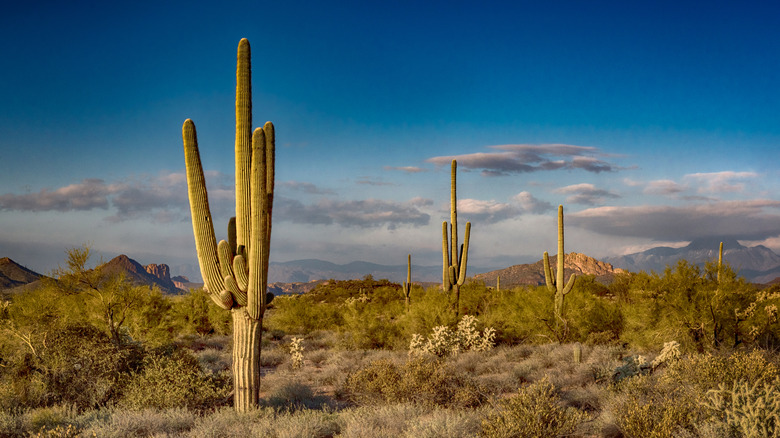Arizona's Most Unexpected Law Is One That Tourists Might Break Without Even Realizing
With the sheer diversity found across U.S. states and their individual communities, it should come as no surprise that some local laws are a little unusual. Take Pacific Grove, a California city called "Butterfly Town U.S.A.," where catching certain butterflies is illegal. Then there's the ordinance in Gainesville, Georgia, prohibiting individuals from eating fried chicken with a fork and knife. But if you've ever encountered one of Arizona's giant saguaro cacti, you may have already broken the law.
Considered an emblem of the American Southwest, these natural wonders can live to be 200 years old, reaching heights between 10 and 50 feet. Cutting down, attempting to transplant, harvesting, carving a name in, or otherwise harming a saguaro cactus is illegal, and a permit is required to move one, according to the state's Native Plant Protection Act. This includes cacti on public and private land, so it's even against the law to remove a saguaro on your own property without a permit.
Although saguaro cacti are not classified as endangered or threatened, they are protected due to their cultural significance. Indigenous groups of the Sonoran Desert, including the O'odham people of the Tohono, Akimel, and Hia'Ced, attribute human qualities to the saguaro and still rely on its ribs for building material. The plant's prickly fruit plays an important role in the Tohono's annual rain ceremony. Its white and yellow blooms, meanwhile, are the Arizona state flower. You can see over 2 million of these incredible plants at the underrated Saguaro National Park and learn about their history at the world-renowned Arizona-Sonora Desert Museum in Tucson.
The punishment for harming an Arizona saguaro cactus
Cutting down a saguaro cactus carries a potential prison sentence of up to 25 years. Keep in mind that this is not a mandatory minimum sentence, so if you hurt a saguaro by accident, you might receive a more lenient sentence than those actively poaching or destroying these protected plants. Regardless, this is a law you definitely don't want to break.
There are also hefty fines associated with damaging a saguaro. These amount to $200 per foot of saguaro trunk or arm, according to the Tucson, Arizona Code of Ordinances. While the penalties may seem extreme, they haven't completely deterred offenders. "We know that there are people who in the past have stolen our saguaros, people ... who know they can sell them. A small saguaro between 0.9 and 1.5 meters can be sold for up to $300," Saguaro National Park Chief Ranger Ray O'Neil told Yucatán Magazine.
Make no mistake, Arizona takes saguaro crime seriously. In 2019, police in Phoenix arrested three men for allegedly using a saguaro as target practice, while Arizona national park officials previously offered a reward for information leading to the arrest of cactus vandals. In addition, over 2,000 cacti at Saguaro National Park have been equipped with microchips to deter black-market poachers.

